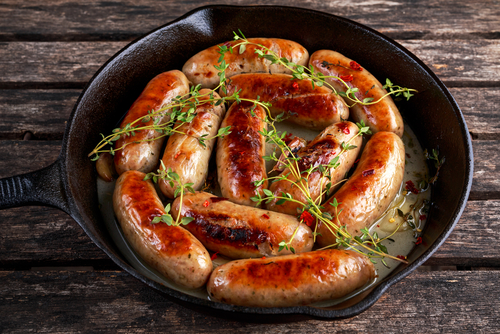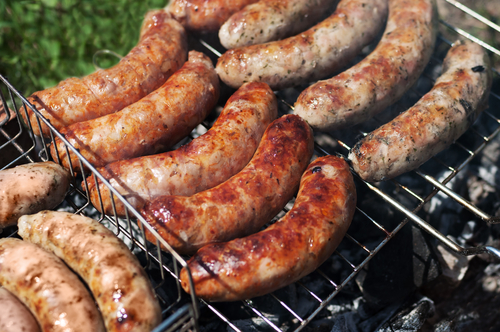How to Cook Sausages
Sausages are a versatile food that can be enjoyed in numerous dishes. Whether you're enjoying a hearty breakfast, preparing a festive celebration, or simply cooking a midweek meal, you can make a difference to farmed animal welfare when you look for the RSPCA Assured logo.
What are Sausages?
The word ‘sausage’ comes from the Latin word “salsus”, meaning salt, which refers to the process of preserving meat by adding salt to it.
What are Higher-Welfare Sausages?
RSPCA Assured higher welfare pork sausages come from pigs raised on RSPCA Assured farms. You can find RSPCA Assured sausages at many supermarkets across the UK when you look for the logo.

Find RSPCA Assured Sausages at your Favourite Supermarket
RSPCA Assured Pig Welfare
You can find out more about the higher welfare standards of salmon on RSPCA Assured farms.
What's the Best Way to Cook Sausages?
The key to cooking the perfect sausages is to keep the heat low and consistent and let them cook for just a little bit longer. Otherwise, they finish up burned and black on the outside, and pink and raw on the inside.
Sausages can be fried, grilled or even baked in the oven if you’re trying to reduce the fat content a little.
Frying Your Sausages
- Place your pan over a medium heat and add your sausages without any oil
- As the pan warms up, oil will seep out from the sausages
- Turn the sausages regularly to coat them and stop one side from burning
- Your sausages are ready when the outsides go golden brown, the insides are white, and any juices running out are clear

Barbecue Hack: Sausages
It may sound terrible to barbecue purists but hear us out. The secret to a great barbecue is in the preparation.
- Pop your sausages into boiling water for about eight to ten minutes before barbecuing them.
- Finish them off over the coals to give them that smokey delicious flavour without running the risk of undercooked sausages.

What Part of the Pig is Sausage?
More expensive sausages are made using prime pork cuts like topside and brisket, whereas cheaper sausages are made from trimmings. To bulk them up and give them their unique flavours, sausages often contain fillers such as breadcrumbs, as well as herbs and spices.
Some cheaper sausages may also contain sausage meal, made of wheat or rice flour. Water is then added to the sausage and absorbed by the meal, which helps to increase the weight. So when you buy cheaper sausages, you're paying for extra water and the more water you add, the more preservatives you need.
Dextrose (a refined sweetener) and hydrolysed vegetable protein made from maize are often used as enhancers and fillers to make the meat go further and taste more.
What are Sausage Casings Made of?
Natural sausage casings are the original and often considered to be the tastiest type of sausage casing. But with the demand for sausage outpacing the supply of natural casings available, alternatives like edible collagen casings derived from cow and pig hides have entered the market. These are mostly used for cheaper sausages and sausages made from other meats (like beef or chicken).
What’s the Difference Between a Hot Dog and a Sausage?
While they are both made from pork, hot dog meat is much more finely ground together with the fat to form a kind of paste that is cooked and eaten with no skin on. The term hot dog is used in America to describe the traditional German food, however, in Germany, there are many different varieties such as Frankfurters and wieners.
Why is Sausage Bad for You?
Sausages have never been renowned for being a healthy food; recent studies have shown that high consumption of red meats (particularly processed meats) has been linked to a higher probability of cancer.
Choosing better quality sausages cannot mitigate any health risks, the best solution is to try and cut down on your meat consumption and to choose better quality products when you do eat it. Our Eat Less, Eat Better campaign is aimed at helping people to swap out meat for meat-free options and to choose higher welfare options when they decide to eat meat.





